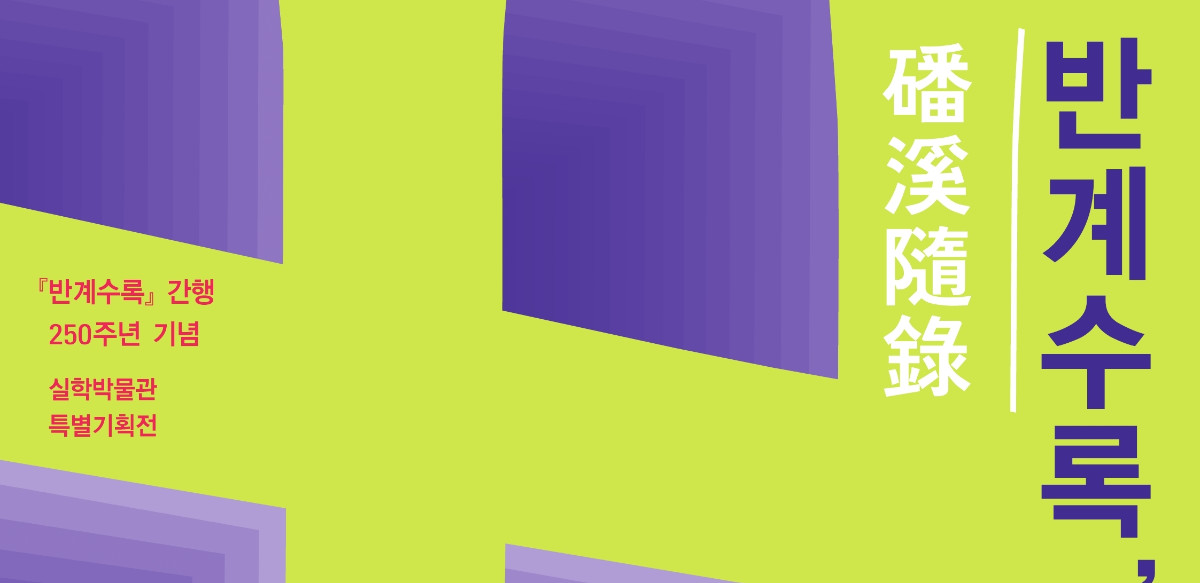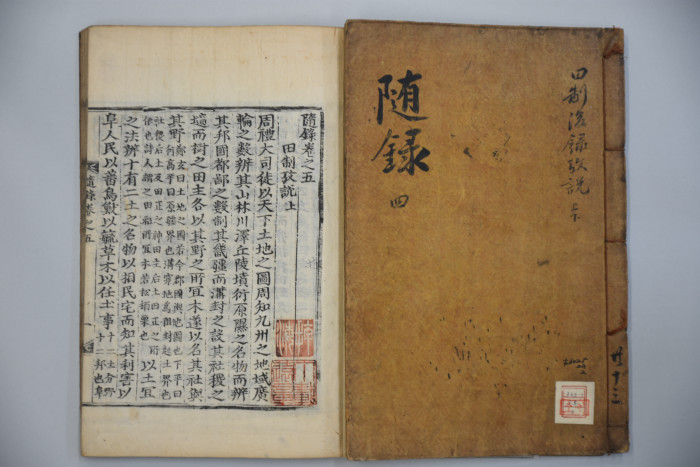※Opening ceremony event will be canceled due to COVID-19.
(16 Dasan-ro-747beon-gil, Joan-myeon, Namyangju-si, Gyeonggi-do)
The Museum of Silhak(Director Taehee Kim), a member of the GyeonGi Cultural Foundation, will hold a special exhibition <Bangye Surok, Planning a Fair Country> on Monday, October 19th with Buan-gun, Jeollanam-do. ‘Bangye Surok’ is the representative writing of Hyungwon Yoo and Bangye (1622~1673), who are considered as pioneers of the academic trend of Silhak, and contains the contents of reforming the whole country. To mark the 350th anniversary of the writing of “Bangye Surok,” and the 250th anniversary of publication this year, we are co-hosting a special exhibition and academic event held on October 23 with Hyungwon Yoo’s ideological hometown, Buan-gun.
‘Bangye Surok’, owned by the Yakyong Jung, Dasan’s family (18th century, woodblock print | MMCA)
The Museum of Silhak said that this exhibition has an important implication today, when a fair world is an issue. Hyungwon Yoo pointed out the law and system operation by self-interest as a problem, and for 19 years wrote a reform proposal to restore the country’s publicity. ‘Bangye Surok’ contains the intense problem consciousness of intellectuals in the late Joseon Dynasty and fundamental solutions.
In this special exhibition, there are over 30 artifacts and 2 videos. Here are some of the first major artifacts to be released.
▶ The first relic to be exhibited this time is ‘Bangye Surok’ held by the ‘Yakyong Jung, Dasan’s family, which proves the process of inheriting the knowledge of Hyungwon Yoo and Yakyong Jung.
▶ Also, the first relic to be released this time includes two letters from Bal Yoo (Hyungwon Yoo’s great-grandson), recording the distribution of ‘Bangye Surok’ nationwide. It specifically indicates the situation that spreads regardless of region and faction.
▶ Finally, this is the entire ‘Bangye Surok’ published in a woodblock print in 1781.
It is the ‘Junjegoseol’ part of ‘Bangye Surok’. It is a woodblock print published in the 18th century, and the owners of ‘Aphae’ and ‘Jungjaewonjang’ are stamped on the inner paper. Jaewon Jung is the father of Yakyong Jung and Dasan who served as Jinju Governor. In view of this, this book is judged to be a collection of Dasan Family, and is a relic that proves the intellectual succession process of ‘Bangye Surok’.
The exhibition is largely composed of 4 parts.
▲ Section 1’s <The Descendants of Cheongbaek-ri Suffered Misfortunes in the Family and Shame by the Country.> covers the trajectory of Hyungwon Yoo’s life. He lost his father to war when he was two years old, and suffered a war in byeongjahoran (The Second Manchu Invasion of Korea) as a boy. His father’s death and national shame awakened Hyungwon Yoo, a boy at the time, and raised his sense of responsibility. Why does the nation suffer from shame and the people’s plagues do not cease? This was his sense of problem.
▲ Section 2’s <Writing a lifelong masterpiece in Buan, the land of reform> directed Hyungwon Yoo’s academic space. Buan-gun, where Bangye Seodang (schoolhouse) is located, boasts one of the best scenery in Jeollanam-do. This space that Hyungwon Yoo looked at was created as a video in the exhibition. Buan was expressed as a region that envisioned the healing of the lung diseases that had plagued him all his life and the reform of the evil he had dreamed of from his youth. Here in Buan, Hyungwon Yoo wrote ‘Bangye Surok’ and completed it at the age of 49 (1670). Soon after completion, Hyungwon Yoo passed away at the age of 52.
▲ Section 3’s <Planning a Fair Country> examines the composition of Hyungwon Yoo’s lifelong masterpiece “Bangye Surok,” completed over 19 years. Hyungwon Yoo believes that the cause of the country’s weakness was that the laws and institutions did not change due to self-interest. “Recovering the publicity of the country” was a fundamental and urgent task. The prescription was ‘Bangye Surok’. He criticized the reasons for the land and suggested the Aerial Warfare system as an alternative, and further argued for the discourse of the past and overall national reform such as education, government office system, Feudal Allowance system, and System of Counties and Prefectures. We have detailed procedures for implementation, not just ideal relief. Hyungwon Yoo was proud that his system plan would be implemented for a long time because it was extremely ‘fair’.
▲ Section 4’s <100 Years of Waiting, Transcending Parties to Raise Silhak> dealt with the process of getting ‘Bangye Surok’ to be recognized as a national governing book after Hyungwon Yoo’s death. What is special about the reevaluation, which took more than 100 years after his death, is the fact that Hyungwon Yoo’s reform proposal was recognized by all over the party, including King Yeongjo and King Jeongjo. And after 100 years, it was published under the name of the king, and it was recognized as a representative writing of the time.
▲ Hyungwon Yoo’s fierce problem-consciousness and fundamental prescription set an example for later scholars. With Hyungwon Yoo’s Statecraft Theory as a stepping stone, Ik Lee, Daeyong Hong, Jiwon Park, Yakyong Jung and others presented Statecraft Theory. These are the reasons why Hyungwon Yoo is called ‘the pioneer of Silhak’.
As Hyungwon Yoo said, it is important for us today to creatively prepare the institution, taking into account the old will according to the current situation. It can be said to be ‘publicity of the state’ and ‘fairness of the system’. The publicity of the state is the basis for the existence of the state, and the impartiality of the institution is a factor for the state to function and maximize the capacity of the community. This is not just the story of the times Hyungwon Yoo lived. The meaning of Hyungwon Yoo’s new plan for the country of Joseon with the topic of ‘public’ and ‘fairness’ is worth exploring with the question ‘What is Silhak?’ to those of us living in the 21st century today while viewing this exhibition.














